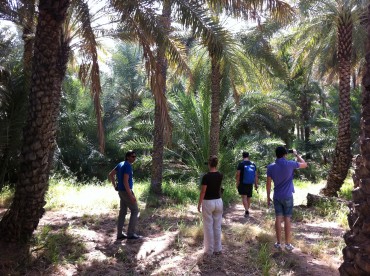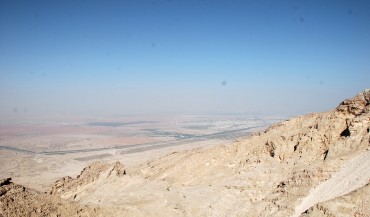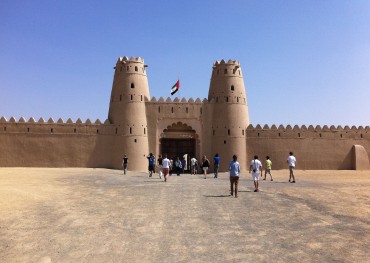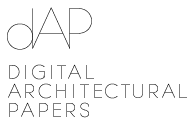
Visit to an oasis during seminarweek hs11, Al-Ain, UAE

View from Jebel Hafeet, Al-Ain

Visit to the fortress during seminarweek hs11, Al-Ain, UAE
4.7.2012 – Issue 6 - Middle East 1 – Baumgartner Marianne, Al Sallal Khaled, Ivanišin Krunoslav, Kenzari Bechir, Hotz Anna, Adham Khaled – Interviews
POSITIONS 2
Interview with Bechir Kenzari, Khaled Adham and Khaled Al Sallal
Why are questions of identity and authenticity so central to the discourse on architecture in the Arab world?
Bechir Kenzari : As far as I am concerned, I think it is a wrong question, it is a false problem. In time of crises the issue of identity becomes a refuge. Eventually it has no meaning as we have seen on the recent elections in Tunisia. The winning party made of the issues of identity. After the elections they turned back to normal speech and eventually the issue or the question has become somehow trivial. I think it’s only a dream that is stressed in time of crisis, such as elections, such as wars etc. And I think it’s just an expression of feeling, because the reason you want to safeguard yourself is that you are aware the inevitable self- annihilation. And I think the Arab nation has been always under threat. And the issue of identity becomes somehow like an anchor; something that needs to be stressed in a way, to be secured. I think for psycho-analytic it’s very easy to explain somehow.
Khaled Adham : Every time I am asked this question, during the last ten years of my career, I think about it differently. I agree with what Bechir said definitely and I just want to add that there still exists this specific relation to the whole history of colonization. We are kind of stuck with our history.
I think we've been stuck with this opposition between modernity and traditions basically since the beginning of 19th century. We've been trying to defend ourselves against modernity; this is how it appears at least at a larger picture, so we've been framed basically by always trying to respond to the modernity as to be on the side of tradition and defending tradition. Probably because of the history of colonization, this binary opposition between modernity and tradition necessitated for us to almost take the side of tradition to defend ourselves. There is still another factor, happening all over the world, which is referred to in the post-modern times as the crisis of identity. In a way we're having a more acute and more intense situation in relation to this question.
Khaled Al Sallal : I just want to add something more specific to the UAE and the Gulf Area. You must not forget that this country is relatively new. It was only about 30- 35 years ago, when everything was imported, and before that there was a very different society. Of course when you build a country from the ground zero to what we see today, the scale of changes is enormous. I think it's normal to lose identity within what was happening here. And not only in architecture, but in architecture it is probably just more obvious.
In Doha, in Abu Dhabi, or even more in Dubai, we have seen many buildings which resemble something: a building which looks like an oyster, a building which looks like a falcon’s feather and so on. What is surprising is that you cannot see any building that looks like a device for extraction of oil, which also makes an important aspect of the local identity.
Khaled Adham : I think we deal with history as with a frozen past. Almost as if you have some icons on the shelf in the back and you go select from it. So I don't think that we deal with history as with a dynamic living process. Oyster-buildings are the result of the very postmodern use of icons like in the late 70‘s and in the 80‘s that works very well in terms of tourism. And it is, in the Gulf, one of the biggest motivations. Lonely Planet in the 70‘s and the 80‘s referred to Doha as to the most boring place on earth. And I can't help myself of thinking that most of the developments happening right now are trying to answer to this.
On one hand, you want to build all those skyscrapers, because you want to respond to this image of modernity that you want to have. But still, to respond to some locals too, saying that we are not losing our identity, you have to go back to this frozen past to select some images and add them to the facade, add them to the city of Doha.
Another very present discourse is the one on sustainability. We have visited a couple of large developments in Doha and in Abu Dhabi, where even developers constantly talk about sustainability, green architecture, ecology on a monumental scale and alike… Is it just another kind of the postmodernist added image or there is a substantial change in attitude behind it? Is it really possible to build a sustainable city in the desert?
Khaled Al Sallal : Of course, the sustainability in general and in architecture in particular was present throughout the history, also in other parts of the world, but stressing it too much is a relatively new phenomenon, especially after the introduction of the new rating systems for green buildings. It took them here at least five years, to realize what is happening outside the Gulf, in other countries, especially in the West. It affected the situation here but I don't think it came as something we believe in, and we don't have many examples anyway. I think maybe the only example is Masdar and Masdar is highly questionable, if it is a sustainable city or not. How many countries in the world have the money and the resources like Abu Dhabi to build such cities? It is a big question, even though it may be designed by one of the best architects and some of the best engineers. But it is also a good exercise for the society to learn from it. I think it conflicts with the meaning of sustainability because sustainability should come from the society as a natural process, right?
Khaled Adham : We are beginning to believe that there is this global city-competition taking place, with something like a checklist of which things should be incorporated in a global city. And so to brand the city as a global city in this competition you have to go through the items on the list, and one of them is sustainability. And so I agree with Khaled that it was never really discussed here until it became actually an issue in Europe and North America. In addition, one of the criteria for selecting global cities is the number of international Headquarters in a city. And so Abu Dhabi has Masdar.
Until a couple of years ago, Dubai was like an icon for global architects. Everybody had to say something about it and at the end everybody was saying the same things. Can you comment on the contemporary reality right now, three or four years after the financial crash? Is Dubai going to continue to grow?
Bechir Kenzari : It started with the real estate, I mean with the stock exchange crisis around 2005, similarly to what was happening in Singapore and South East Asia before. Stocks were overvalued, and it, among other things, generated a crisis in the real estate market because people were investing into the building industry and then they drew their money or gave up or left. The sight of people leaving their cars at the airport is only one aspect of the situation. They have put a lot of hope into the future and then the situation changed and therefore they had to leave. What happened is the balloon-effect, although it is a bit folkloric as a notion. The cycle has come to its end and it had to go down and now it seems it is speeding up again a bit. Dubai had some financial problems and Abu Dhabi had intervened and rescued them. Things are stabilizing to my understanding. And this is not optimism; this is just the nature of things.
Khaled Adham : It is a very complicated question. Referring back to this idea of global cities … If you look at the world map, with global cities on it, you will see between Hong Kong and Europe no city, up until Dubai actually emerged on the scene, having a strong stock market or any presence in the financial world. There was a geographic need for Dubai in this part of the world, for the simple reason, considering the time difference between the stock markets openings in Japan and in Hong Kong to the ones in Switzerland or in London, of something like eight, nine hours, when money was actually waiting to circulate. There was a need for a place in the middle. And so Dubai picked up this idea. The hit on the financial system has slowed down everybody but it also gives some new players like Doha and Abu Dhabi the time to catch up. It is very difficult to know what will happen because now there are two other players in the area who are competing for their share in terms of stock markets and terms of presence of international companies, attracting tourism et cetera. Let alone that the entire Gulf is very woundable to political changes, and the world changes, isn’t it?
One could say that the global capitalism has embodied itself in a certain kind of form, be it the ornamental urbanism of the Palm Jumeirah. On the other hand, there is the Arab Spring. Do you think that this revolution is going to take a physical form too?
Bechir Kenzari : The Arab Spring is happening in countries with serious social problems. Tunisia, Libya, Egypt, Syria, Yemen. People have revolted there because they had enough. Eventually, it will get some physical form, but I think your question is about architectural physical forms. I don't think it is going to appear in the near future. There are some urgent issues that we are addressing economically, socially. And as soon as the democratic process is installed, those countries can start going forward and eventually investment issues will be addressed. But I don’t think it is going to happen for three or four years at least.
I think the nature of the Arab revolution is essentially political and social. The economic part, assuming that architecture is part of the economic agenda, would not be triggered or launched in the coming years. It needs some time. You need stability, you need investment, you need trust, you need money coming back, you need tourism coming back, you need stock exchanges et cetera. And then you can see things emerging out of the ground. It doesn’t make sense that while having still fragile situations like in Libya for instance, you will see people coming and investing their money somewhere which is still risky. So the issue of stability, security, peace is essential to any formal, physical, architectural development in the future.
Khaled Adham : I think it’s too early to say that there is an architecture coming out of it. But I also have a feeling that, when it started in Tunisia and Egypt, there was a great enthusiasm especially from a part of the left in the West, looking for signs of a true, genuine, new economic regime that would basically answer the question of no alternative to the one that Margret Thatcher has put in the eighties. So there was this window that opened in the Middle East for a possible alternative. Honestly speaking, I haven’t seen any change in the economic regime related to the revolutions, at least so far. They all basically still work within the old system. So I don’t see in the near future any change in architecture or even in city planning. We still advertise gated communities. You have same old advertisements, changed from a kind of very elitist secluded places, to a more socialist kind of images. So again, I don’t see a change in the political, economic regime and so I don’t think in the nearer future we will see a real change. Maybe as Bechir said, in twenty, thirty years if there is really a change on the social level.
You come from different parts of the world, you have studied abroad and now you are all involved in teaching here in the Emirates. What is specific in teaching architecture here in Al Ain, which is different from teaching architecture in Cairo for instance?
Khaled Al Sallal : I don’t see much difference; it is very similar to any architectural program in the region here. Specific to our program is that we are shifting toward engineering or architectural engineering. There is a course that I am teaching, Building in hot arid zones, which is specific to the climate here, focusing on issues like passive cooling which is a big issue in dessert climates. There is also an elective course on architectural heritage of this area.
Bechir Kenzari : There is a major problem in architectural education in the entire Arab world. I come from the Western part of Tunisia which is more Francophile, but I can see the same problem there. Mainly, the education is not taken seriously at the foundational level. If you don’t have a good elementary and secondary educational system the tertiary sector will suffer eventually. The major handicap of all education, and nowadays it is becoming alike everywhere, is a lack of attention to humanities, to philosophy, to sociology and anthropology. The major program might be engineering, but that’s not an issue. So if you are creating elite, a technocratic leadership, that is not trained in this humanistic tradition, you will end up with a technicist approach to the development, which can have very negative effects. Having taught in the U.S. and in New Zealand, I think that our major problem here is that we are not taking design seriously. Our program is still an engineering program; architecture is becoming almost secondary comparing to engineering issues. Between us and the civil engineering there is a very narrow gap and it is a big mistake because we need an education grounded in plastic arts, digital fabrication, environmental issues from the part of architecture, not engineering. That is specific for certain schools in this area. The continental and American system is unfortunately not fully applied here. Only certain aspects are selected and addressed but not the whole process. We don’t have courses in philosophy, communication, humanities as you do have in major schools in North America and Europe and we are producing architects who are not qualified internationally speaking to open dialogue with their counterparts worldwide. And my fear is that if no attention is paid to this, we will end up with quasi-architectural programs, but no genuine architectural programs. If you apply an American or European system you should apply it fully, because in that case you can at least compare.
Khaled Adham : From my own experience in teaching in the U.S., in Egypt and here, I would say that the human motivation is probably the only thing I could distinguish between here and other places. Students in Egypt don’t get as much facilities, nor do they get all these free funds and books etc etc, and they also know that to a great extend when they finish they will have to compete in the market for jobs, so they really don’t have a choice but to work very hard to get there. Here we are giving all these conditions and all these facilities for free. Some students are motivated, I have to admit, which surprises me sometimes. But in general it’s a big thing to motivate people to work really hard. The other thing which is more acute here than in other places is this tradition of anti-intellectualism. In the studio it is random that we really meet students who really willing to read literature and to try to relate it to their ideas.
Khaled Adham, Bechir Kenzari and Khaled Al Sallal are associate professors at the Architectural Engineering Department of the United Arab Emirates University, College of Engineering in Al Ain.
In parallel to the practice in architecture and urban planning, Khaled Adham taught architectural theory courses, design studios, and supervised graduation projects. His current research focuses on the architectural and urban transformations of Cairo, Doha, and Dubai. Bechir Kenzari has lectured in the areas of philosophy, architectural design and digital fabrication. His writing has appeared in several international journals such as the JAE, Architectural Theory Review, The Built Environment. He is the editor of Architecture and Violence, recently published by Actar. Khaled Al Sallal’s area of expertise is sustainable design. He has been involved in projects that introduced new building sustainable technologies to the UAE and the Middle East. He has designed several residential and public buildings and won architectural design competition.
Interviews by Marianne Baumgartner, Anna Hotz and Krunoslav Ivanisin during the seminar week of the Chair of Prof. Dr. Josep Lluis Mateo to Qatar and the Emirates
Download article as PDF

